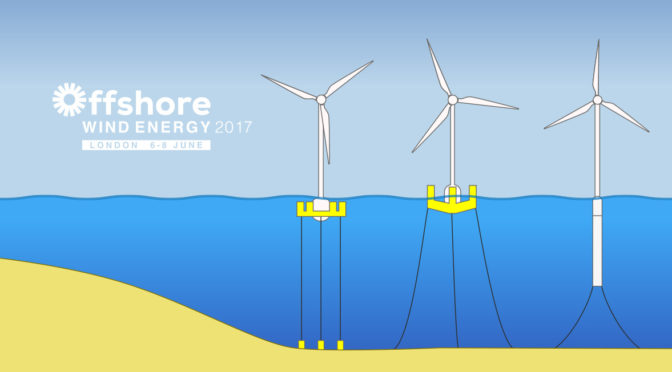An estimated 70 GW of floating wind power could be installed across the globe by 2040, according to forecasts contained in the Carbon Trust’s new Floating Wind Joint Industry Project’s (JIP’s) second phase summary report.
The nascent sector could expand rapidly to deliver £195bn worth of projects, the report adds, underscoring the “opportunity for the supply chain globally to support and invest in floating wind”. Even in the shorter term, the study predicts the sector delivering up to 10.7 GW of global floating wind energy capacity by 2030.
Floating wind technology enables offshore wind turbine installation in deeper waters not suitable for bottom-fixed turbines, opening up large swathes of the planet’s surface to renewable energy generation. Pilot projects have shown the potential for similar, or even higher yields from floating turbines compared to bottom-fixed projects, as they can be situated in locations with higher wind resource. Advocates of the approach also predict that it could lead to lower development costs, as floating technologies do not require foundation structures.
However, the report acknowledges that technological challenges remain across four main areas: turbine requirements and foundations scaling; heavy lift offshore operations; dynamic export cables; and monitoring and inspection.
Since 2016, the Floating Wind JIP, a collaborative research and development initative between the Carbon Trust, Scottish Government, and 15 leading international offshore wind developers, has been working to develop solutions to each of these issues.
Its latest report covers the second phase of its research, alongside market projections for the next 20 years. It covers a promising study by Danish engineering firm Ramboll, which suggested that only minor modifications would be needed for floating structures to be able to use larger, next generation turbines. It also details progress on the development of suitable power cables to transport power from floating offshore wind farms, the absence of which had previously been highlighted by the JIP, which is currently supporting five cable manufacturers to design the necessary high voltage dynamic export cables.
Significant challenges remain, however, in finding solutions for the monitoring, inspection, and installation of the floating structures. A heavy lift offshore operations study undertaken by Seaway 7 investigated the challenges associated with floating heavy lift offshore construction and maintenance operations for turbines up to 20MW, finding that the limited availability and high cost of suitable floating heavy lift vessels presents a significant barrier to cost effectively undertaking operations offshore.
Despite such challenges, however, the report concludes there is massive growth potential for floating wind. “We expect that it will become a key sector for low carbon power generation and economic growth in geographies where deeper waters do not allow for bottom-fixed offshore wind turbines,” said Dany Kyle Spearman, manager of the Floating Wind JIP at the Carbon Trust.
“The time is now for the floating wind industry to look to pre-commercial and commercial projects to deliver the cost reduction necessary for the sector to compete with other renewable energy options.”
Scottish Energy Minister Paul Wheelhouse also voiced optimism about the technology’s potential.
“The development of floating wind offers a massive opportunity for sustainable growth of the Scottish economy while realising our net zero ambitions,” he said.
The study follows on from phase one of the JIP’s work, which started with a focus on electrical systems, mooring systems, and logistics for construction and operation for floating wind. Findings were published from these projects in 2018.
The report comes just days after Irish developer Simply Blue Energy took the first steps towards delivering the Emerald project, an ambitious plan to deploy a floating offshore wind farm that would harness the wind potential of the Celtic Sea.
An application has been made to the Irish Department of Housing, Local Government and Heritage for a license to carry out initial site investigation works in an area off the Kinsale coast, County Cork, Ireland.
The project is intended to be delivered as a staged development, starting with a pre-commercial array of approximately 100MW capacity and building to an overall capacity of 1GW upon final completion.
“Ireland has massive unrealised potential for offshore wind energy production, particularly on the south and west coasts, and state of the art floating wind technology is the key to unlocking that potential,” said Sam Roch-Perks, managing director of Simply Blue Energy Ltd. “With a sea area 10 times that of our land mass, we have a chance to catch and become a leader in offshore wind energy production both in Europe and globally, allowing us to become the ‘Green Gulf’ of renewable energy.”


